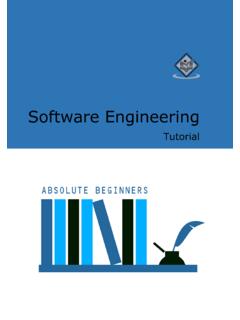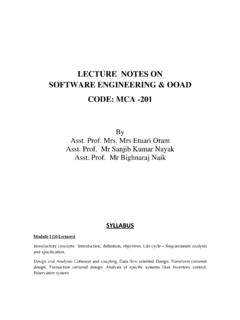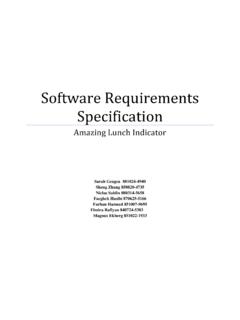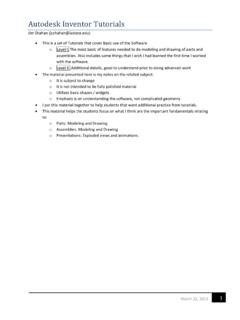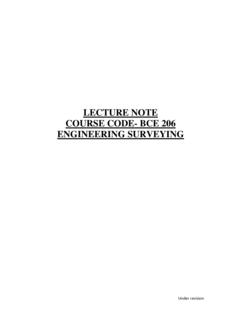Transcription of SOFTWARE ENGINEERING - BCA Notes
1 SOFTWARE ENGINEERING Name of modules:- 1) Fundamental of 2) System analysis 3) System planning 4) System design 5) System documentation 6) Coding and programming 7) SOFTWARE testing 8) Cost and time estimation 9) SOFTWARE project management 10) SOFTWARE quality 11) CASE. Top level Middle level Low level Set of instruction-> this is program. Set of program-> SOFTWARE . This SOFTWARE is a collection of computer programs, procedure, rules and associative documentation and data. Program is generally used the developer of a specific program to make a particular SOFTWARE . Q) Some characteristics of SOFTWARE includes:- 1) SOFTWARE is developed or engineer. 2) Most of SOFTWARE is custom build rather than assemble from existing component. 3) Computer program and associated documentation. 4) Easy to modified. 5) Easy to reproduce. 6) SOFTWARE product may be developed for a particular customer or for the general market.
2 Q) Difference between program and SOFTWARE . program SOFTWARE 1) Small in size. 2) Authors himself is user-soul. 3) Single developer. 4) Adopt development. 5) Lack proper interface. 6) Large proper documentation. 1) Large in size. 2) Large number. 3) Team developer. 4) Systematic development. 5) Well define interface. 6) Well documented. Definition of SOFTWARE : - it is systematic approach to the development, operation, maintenance and retirement of SOFTWARE . It is the application of computer science along with mathematics and ergative science. In the current scenario the has a specific importance for making particular SOFTWARE . Why SOFTWARE ENGINEERING :- 1) In the late 1960 s hardware price were falling but SOFTWARE price rising. 2) Many SOFTWARE projects failed. 3) Large SOFTWARE project required large development loams. 4) Many SOFTWARE project late and over budget. 5) Complicity of SOFTWARE project is increased.
3 6) Demand for new SOFTWARE on the market. Why study SOFTWARE ENGINEERING ? 1) Higher productivity. 2) To acquire skills to develop large programs. 3) Ability to solve complex programming problems. 4) Learn techniques of specification design. 5) Better quality programmers. Application of SOFTWARE :- 1) System SOFTWARE . 2) Application SOFTWARE . 3) ENGINEERING /scientific SOFTWARE . 4) Embedded SOFTWARE . 5) Product line SOFTWARE . 6) Web application SOFTWARE . 7) Artificial intelligence SOFTWARE (AI). 1) The concept analysis in the view of 2) System development life cycle (SDLC). 3) SOFTWARE requirement specification (SRS). 4) Object- data base and flow base analysis. 5) Models- spiral, water fall model. 1) The concept analysis in the view of :- in the the analysis phase helps to determine from the starting of the project to the end of the project. It has some specific phase. We can make particular SOFTWARE for real time use.
4 The term analysis define the corresponding phase or stage by which the SOFTWARE developer can make a successful SOFTWARE . In the the analyst has some specific job which is involved for making SOFTWARE . In a overview we can say that the SOFTWARE analysis is a main term through we can developed, operate and maintain a particular SOFTWARE . In the view of SOFTWARE developer as well as the user. The SOFTWARE analysis we can determine by the view of two Side. a) For the SOFTWARE developer. b) For the customer (client). System development life cycle (SDLC):- SDLC is an approach for making SOFTWARE for the developer, user and customer. SDLC focus on the internal phase to the end phase for making particular SOFTWARE . It generally deals with the analyst and the corresponding clients. SDLC has some specific phase. This are- 1) project identification 2) feasibility study 3) system analysis 4) system design 5) system development 6) system testing 7) system implementation 8) system maintenance 9) system documentation 1) Project identification: - in this phase the analyst focus the basic objective and identification need for the corresponding SOFTWARE .
5 In this phase the analyst set up some meeting with the corresponding client for making the desired SOFTWARE . 2) Feasibility study: - feasibility defines in the three views for making particular SOFTWARE for the client. a) Technical b) financial c) social feasibility. 3) System analysis: - analysis defines how and what type of desired SOFTWARE we have to make for the client. It has some pen and paper base. Exercise through which the analyst focused for there desired goals. 4) System design: - in this phase the analyst draw the corresponding diagrams related to the particular SOFTWARE . in this phase the design include in the form of flow chat, data flow diagram, ntt relationship diagram (NRD). 5) System development: - development refers in the form of coding, error checking and debarking for the particular SOFTWARE . This phase deals with the developer activity for making a successfully SOFTWARE . 6) System testing: - testing refers whatever analyst and developer done will it be correct and error free to the desired SOFTWARE .
6 In the there some testing technique to which we can check whether project is error free. Problem in the particular SOFTWARE . The main testing techniques are 1) white box testing 2) black box testing 3) ad hope testing 4) system testing 5) unit testing 6) alpha testing 7) beta testing 7) System implementation: - after completing the testing phase we have to implement a particular product or system according to the customer need. In the implementation phase some design and other user activity part may be changed as per customer need. 8) System maintenance: - after implementation the users use the particular SOFTWARE to there corresponding operation to active there job. In this phase the SOFTWARE maintained from the user or developer side after spanning some times of use of particular SOFTWARE . In this phase the related hardware, SOFTWARE and other utilities are also maintained.
7 9) System documentation: - documentation refers the approach and guidelines for the user as well as the customer to the related SOFTWARE . The documentation refers some writing instruction for how to use for related hardware requirement, and also some maintains factors for the users. Srs ( SOFTWARE requirement specification)- Definition- SRS is a complete reading base documentation focus on the particular desired SOFTWARE to the specific client or customer. After collecting the necessary data from SDLC we have to summarize the useful and appropriate data for making desired SOFTWARE . SRS has some objectives which is help to the SOFTWARE developer as well as the customer for making a successfully SOFTWARE . Characteristics of SRS- 1) complete 2) traceable 3) appropriate for the developer 4) modifiable 5) simple language 6) SOFTWARE requirement view Good SRS: - SRS is a very important for fact gathering technique which include the consider delimiting with the customer gather previous information related to particular SOFTWARE and returned on investment the good characteristics of SRS includes the following activities: 1) It focuses on summarized from for a particular SOFTWARE specification.
8 2) The completeness deserves the related phase for making a required specification. 3) The traceable factor focus on the modification part when ever it necessary for the development of SRS. Waterfall model: - waterfall model linear representation of its face for developing a particular system in this model. These phases are: 1) Communication (requirement analysis, specification). 2) Planning (estimating, seducing). 3) Modeling (analysis, design). 4) Construction (code, test). 5) Deployment (delegacy, support, fid back). a) This phase involve the whole working process for making a particular SOFTWARE for desired client. b) Iterative waterfall model and the classical waterfall model are the two types are these model available calices. We have to follow the linear stage or phase which are available in waterfall model. But in the iterative model we can jump over from one phase to another phase. Disadvantages of waterfall model:- 1) In real life the project are sequential.
9 2) Intel finished the project the working versa is not available for the customer. 3) Hardware implementation in the middle of the project is fact. 4) In this model the risk factor is not available. Spiral model: - the spiral model is a step by step process it stresses on the risk factor of the SDLC. The stages of the model are: 1) planning 2) risk analysis 3) development 4) customer assessment a) determine objective alternative b) evaluative alternative risk analysis c) development and product d) plane for next phase From the above figure we can see that there are four parts including some loops how ever the number of loops is not fixed depending on the project. Spiral model has a special type of focus on risk factor by which it has make some difference from the other model. In this model the phases are planning, risk analysis, development and customer assessment. From the diagram we can say that first quadrant which representation and make some object and determine the analysis for a particular project.
10 The next part deals and evaluated some alternative way by which we can achieve a simple solution. In this phase the risk analysis is also measured depending on the project. Difference between system analysis and system design- System analysis System design 1) System analysis is the examination of the problem. 2) It is concerned with identifying all constrains. 3) It deals with data collection and a datelined evaluation of existing file. 4) In system analysis part the main focus on data flow diagram and data dictionary. 1) System design is the creator of information system which is solution to the program. 2) It is concerned with co erudition of the activities for a particular system goal. 3) It deals with general design specification detailed design specification I/O files and procedures. It also deals with program construction testing and user acceptance. 4) It provides technical specification and reports by which problems can be trapped.






